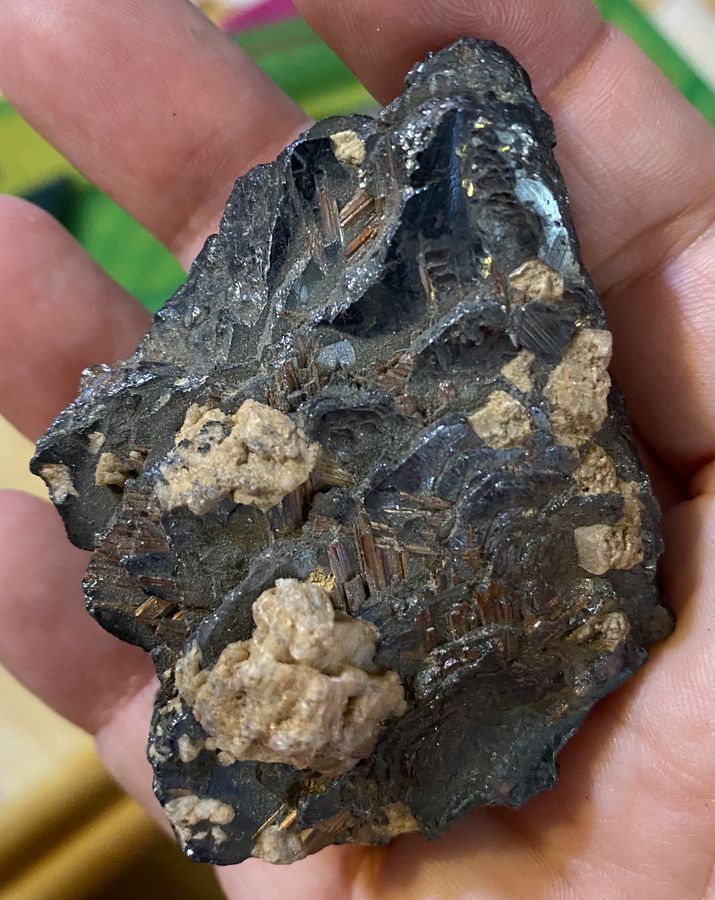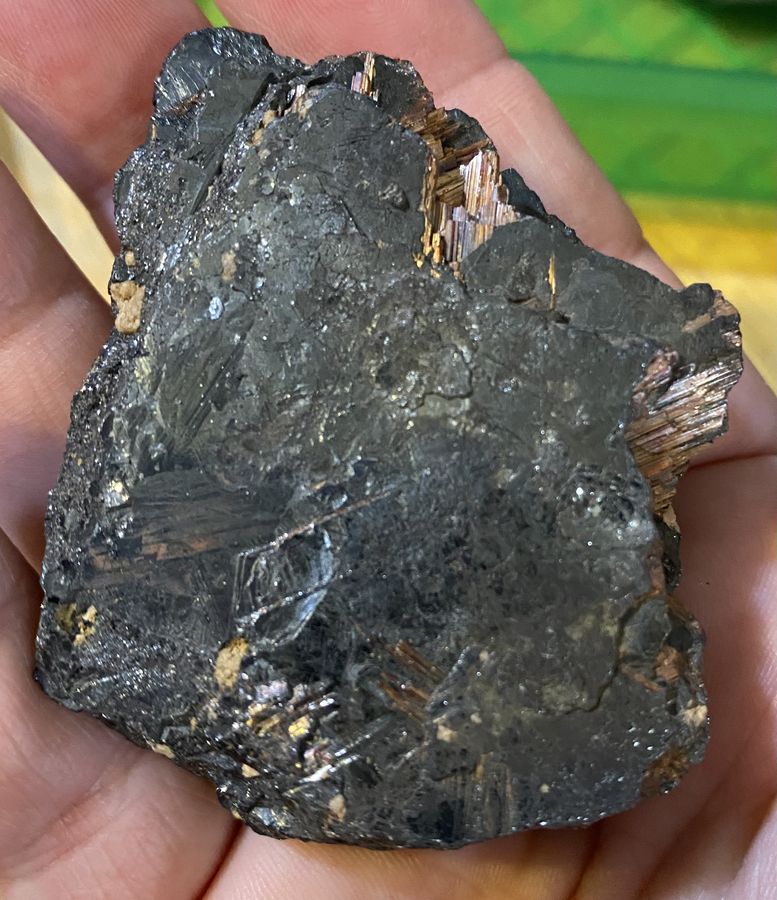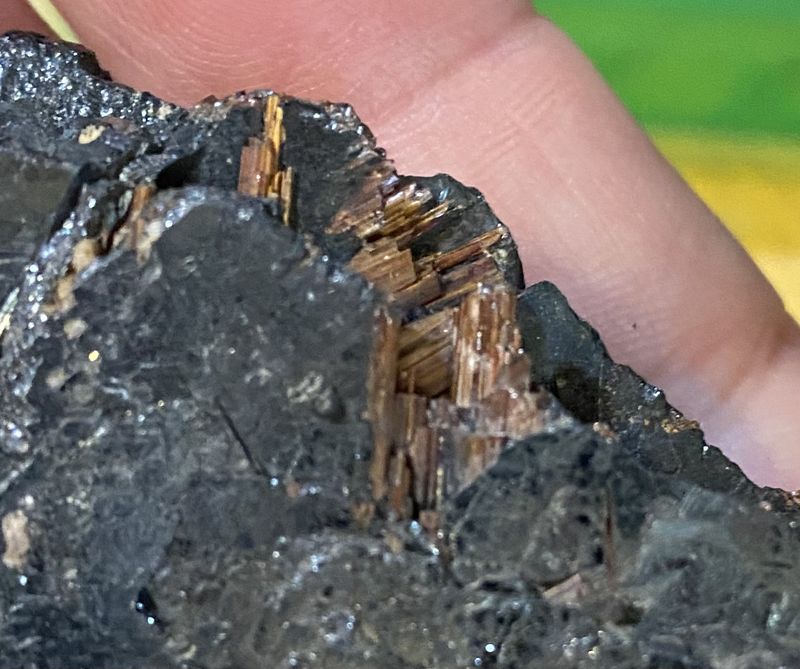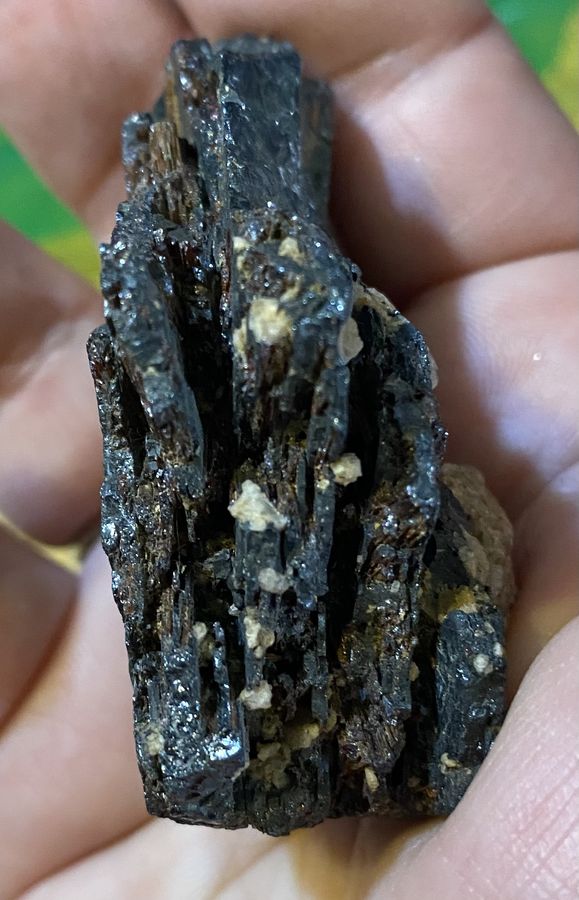| View previous topic :: View next topic |
| Author |
Message |
VTinNorthAB
Joined: 15 Mar 2022
Posts: 8
Location: Alberta


|
 Posted: Mar 16, 2022 10:11 Post subject: Unknown metallic mineral Posted: Mar 16, 2022 10:11 Post subject: Unknown metallic mineral |
|
|
Hello all!
Here is another mystery specimen from the shop I used to work at :). No location. No information. It isn't scratched by quartz and doesn’t scratch quartz but does leave a black streak behind. It’s not magnetic however, it feels like it pushes the magnet away as if there’s a bit of resistance. It’s pretty heavy for its size at 150g. It has little copper coloured bands in it. It reminds me of the chunk of tungsten ore I have but the little copper streaks throw me off. I thought it was a type of galena but I’m not so sure. If there are any tests that could be recommended, I will try my best.
I appreciate all help! :)
| Mineral: | Unknown |
| Dimensions: | 7cm x 6cm x 2cm |
| Description: |
|
| Viewed: |
10301 Time(s) |

|
| Mineral: | Unknown |
| Dimensions: | 7cm x 6cm x 2cm |
| Description: |
|
| Viewed: |
10309 Time(s) |

|
| Mineral: | Unknown |
| Dimensions: | 7cm x 6cm x 2cm |
| Description: |
|
| Viewed: |
10275 Time(s) |

|
| Mineral: | Unknown |
| Dimensions: | 7cm x 6cm x 2cm |
| Description: |
|
| Viewed: |
10284 Time(s) |

|
|
|
| Back to top |
|
 |
kushmeja
Joined: 28 Jul 2014
Posts: 244
Location: New Jersey



|
 Posted: Mar 16, 2022 10:18 Post subject: Re: Unknown metallic mineral Posted: Mar 16, 2022 10:18 Post subject: Re: Unknown metallic mineral |
|
|
| The black is Hematite & the gold is Rutile. It is from Novo Horizonte, Bahia, Brazil.
|
|
| Back to top |
|
 |
Bob Carnein
Joined: 22 Aug 2013
Posts: 355
Location: Florissant, CO



|
 Posted: Mar 16, 2022 10:26 Post subject: Re: Unknown metallic mineral Posted: Mar 16, 2022 10:26 Post subject: Re: Unknown metallic mineral |
|
|
The "little copper coloured bands" look like rutile; I'd suggest you look up rutile and see whether the hardness and other properties agree. The specimen looks like two intergrown minerals.
The part about "it doesn't scratch quartz and isn't scratched by quartz" doesn't really make sense. Which mineral are you referring to? If it's the black one, there are several possibilities; for example, ilmenite comes to mind. I'd try a knife blade and look up the properties of minerals that commonly occur with rutile.
|
|
| Back to top |
|
 |
VTinNorthAB
Joined: 15 Mar 2022
Posts: 8
Location: Alberta


|
 Posted: Mar 16, 2022 10:31 Post subject: Re: Unknown metallic mineral Posted: Mar 16, 2022 10:31 Post subject: Re: Unknown metallic mineral |
|
|
| Bob Carnein wrote: | The "little copper coloured bands" look like rutile; I'd suggest you look up rutile and see whether the hardness and other properties agree. The specimen looks like two intergrown minerals.
The part about "it doesn't scratch quartz and isn't scratched by quartz" doesn't really make sense. Which mineral are you referring to? If it's the black one, there are several possibilities; for example, ilmenite comes to mind. I'd try a knife blade and look up the properties of minerals that commonly occur with rutile. |
Oh sorry, was trying to figure out how to explain. The black mineral doesn’t scratch quartz but leaves a black streak. Quartz doesn’t leave a scratch mark on the black mineral when I scratch it. I don’t really know how else to test hardness :)
|
|
| Back to top |
|
 |
Bob Carnein
Joined: 22 Aug 2013
Posts: 355
Location: Florissant, CO



|
 Posted: Mar 16, 2022 10:44 Post subject: Re: Unknown metallic mineral Posted: Mar 16, 2022 10:44 Post subject: Re: Unknown metallic mineral |
|
|
When you test hardness, it's always best to try the test "both ways". For example, try scratching the mineral with a knife blade, and then try scratching the knife blade with the mineral. Sometimes, if the mineral is brittle and its surface is irregular, the knife blade may break the mineral, creating what looks like a scratch but really isn't. If you get inconsistent results, try some other tests.
BTW, if the streak color is truly black, then the black mineral probably isn't hematite.
|
|
| Back to top |
|
 |
VTinNorthAB
Joined: 15 Mar 2022
Posts: 8
Location: Alberta


|
 Posted: Mar 16, 2022 10:51 Post subject: Re: Unknown metallic mineral Posted: Mar 16, 2022 10:51 Post subject: Re: Unknown metallic mineral |
|
|
| Bob Carnein wrote: | When you test hardness, it's always best to try the test "both ways". For example, try scratching the mineral with a knife blade, and then try scratching the knife blade with the mineral. Sometimes, if the mineral is brittle and its surface is irregular, the knife blade may break the mineral, creating what looks like a scratch but really isn't. If you get inconsistent results, try some other tests.
BTW, if the streak color is truly black, then the black mineral probably isn't hematite. |
Ok I will try to scratch a knife blade and with a knife blade and see :) thanks for the information!
|
|
| Back to top |
|
 |
Pete Modreski
Site Admin

Joined: 30 Jul 2007
Posts: 710
Location: Denver, Colorado



|
 Posted: Mar 16, 2022 10:56 Post subject: Re: Unknown metallic mineral Posted: Mar 16, 2022 10:56 Post subject: Re: Unknown metallic mineral |
|
|
When two minerals are both quite hard and are of comparable hardness, it can be quite difficult to do a reliable hardness scratch test; it sounds like both it and quartz are "near 7" in hardness. It can be difficult to get a clear result from the scratch test vs. quartz when the mineral has a hardness, say, of 6 or 6-1/2 vs. 7; especially if the crystal (and, the quartz too) do not have perfectly flat and smooth crystal faces to try scratching--any striations or surface irregularities may confuse the test.
As mentioned, hematite and ilmenite seem the most likely possibilities; less likely (because of rarity), ferberite/wolframite. Try doing a streak test again on (worth ordering one, if you don't have one) a "real" streak plate; if your mineral does not have a reddish-brown streak, then you can rule out hematite. (I think that just coarsely crushed fragments, from attempting to scratch quartz, and the mineral scrapes against the striations on the prism faces of quartz, of crystalline hematite might still look black, because they have not been ground to a true fine-grained powder.
hematite, hardness 6-1/2 (if crystalline), streak red-brown, non-magnetic
ilmenite, hardness 6 (if crystalline & unaltered), streak "black to brownish red" (not very helpful??), slightly magnetic
wolframite, hardness around 4-1/2 (notably softer), streak black to brown, non-magnetic; and notably much heavier (sp. gr. around 7.t, vs. hematite 5.2, ilmenite 4.7).
Also, my bit of advice when testing magnetism; use a "classic", old-fashioned, iron magnet, not the state-of-the-art rare-earth magnetics, which are so powerful that they may stick to almost any mineral that contains iron. (Or, use both and compare, but be sure to use an old "simple" magnet to discern what is "magnetic vs. slightly magnetic vs. not at all".)
Best of luck figuring this out!
|
|
| Back to top |
|
 |
VTinNorthAB
Joined: 15 Mar 2022
Posts: 8
Location: Alberta


|
 Posted: Mar 16, 2022 11:01 Post subject: Re: Unknown metallic mineral Posted: Mar 16, 2022 11:01 Post subject: Re: Unknown metallic mineral |
|
|
| Thank you all for the information! I love reading it. I will buy a streak plate and see what it shows! I appreciate all the responses!
|
|
| Back to top |
|
 |
Pete Modreski
Site Admin

Joined: 30 Jul 2007
Posts: 710
Location: Denver, Colorado



|
 Posted: Mar 16, 2022 11:32 Post subject: Re: Unknown metallic mineral Posted: Mar 16, 2022 11:32 Post subject: Re: Unknown metallic mineral |
|
|
| Viewing your pictures again--considering the intergrown rutile--yes, I agree with what's been suggested, for sure, hematite with rutile, from Brazil.
|
|
| Back to top |
|
 |
SteveB
Joined: 12 Oct 2015
Posts: 239
Location: Canberra


|
 Posted: Mar 16, 2022 19:17 Post subject: Re: Unknown metallic mineral Posted: Mar 16, 2022 19:17 Post subject: Re: Unknown metallic mineral |
|
|
I would highly recommend investing in a set of hardness scribes which are specifically for determining hardness. The “use glass/quartz/knife” advice is meant for children to help understand the principle and are of minimal use for real identification unless you have hardness calibrated pieces of glass etc. laying around (LOL), and knives especially vary greatly in hardness due to the composition of the metal. Also, they could be surface hardened for cutting so depending on what knife you use, you can be wildly off in measurement. The scribe set is much more accurate plus much easier to reach in to test just a specific mineral inside the rock, like here you have two clear minerals together, so you need to be certain you test each one separately. The scribes also give your hand a good feel for knowing you’ve scratched the surface for certain as sometimes it can be tricky.
But here it's the crystalline shape of the rutile that's a big identification factor not just its colour or hardness. Which is why a good loupe magnifier is an essential part of your examination kit as many rocks contain crystals (the pure form of a mineral) but very small and you need to examine close to look for the crystalline structure and cleavage planes (another important identification data point).
|
|
| Back to top |
|
 |
James Catmur
Site Admin

Joined: 14 Sep 2006
Posts: 1479
Location: Cambridge



|
 Posted: Mar 17, 2022 01:29 Post subject: Re: Unknown metallic mineral Posted: Mar 17, 2022 01:29 Post subject: Re: Unknown metallic mineral |
|
|
I agree
| Pete Modreski wrote: | | Viewing your pictures again--considering the intergrown rutile--yes, I agree with what's been suggested, for sure, hematite with rutile, from Brazil. |
|
|
| Back to top |
|
 |
VTinNorthAB
Joined: 15 Mar 2022
Posts: 8
Location: Alberta


|
 Posted: Mar 17, 2022 07:49 Post subject: Re: Unknown metallic mineral Posted: Mar 17, 2022 07:49 Post subject: Re: Unknown metallic mineral |
|
|
| You all are awesome! Thank you so much!
|
|
| Back to top |
|
 |
Roger Warin

Joined: 23 Jan 2013
Posts: 1243



|
 Posted: Mar 17, 2022 14:16 Post subject: Re: Unknown metallic mineral Posted: Mar 17, 2022 14:16 Post subject: Re: Unknown metallic mineral |
|
|
| It's an epitaxy of rutile
|
|
| Back to top |
|
 |
|





